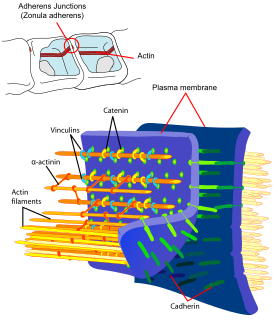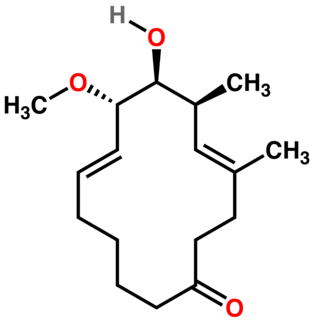
Metastasis is a pathogenic agent's spread from an initial or primary site to a different or secondary site within the host's body; the term is typically used when referring to metastasis by a cancerous tumor. The newly pathological sites, then, are metastases (mets). It is generally distinguished from cancer invasion, which is the direct extension and penetration by cancer cells into neighboring tissues.

Catenins are a family of proteins found in complexes with cadherin cell adhesion molecules of animal cells. The first two catenins that were identified became known as α-catenin and β-catenin. α-Catenin can bind to β-catenin and can also bind filamentous actin (F-actin). β-Catenin binds directly to the cytoplasmic tail of classical cadherins. Additional catenins such as γ-catenin and δ-catenin have been identified. The name "catenin" was originally selected because it was suspected that catenins might link cadherins to the cytoskeleton.
The epithelial–mesenchymal transition (EMT) is a process by which epithelial cells lose their cell polarity and cell–cell adhesion, and gain migratory and invasive properties to become mesenchymal stem cells; these are multipotent stromal cells that can differentiate into a variety of cell types. EMT is essential for numerous developmental processes including mesoderm formation and neural tube formation. EMT has also been shown to occur in wound healing, in organ fibrosis and in the initiation of metastasis in cancer progression.

P-selectin is a type-1 transmembrane protein that in humans is encoded by the SELP gene.

Plicamycin is an antineoplastic antibiotic produced by Streptomyces plicatus. It is an RNA synthesis inhibitor. The manufacturer discontinued production in 2000. Several different structures are currently reported in different places all with the same chromomycin core, but with different stereochemistry in the glycoside chain, a 1999 study has re-investigated the compound and proposed a revised structure.

72 kDa type IV collagenase also known as matrix metalloproteinase-2 (MMP-2) and gelatinase A is an enzyme that in humans is encoded by the MMP2 gene. The MMP2 gene is located on chromosome 16 at position 12.2.
A Janus molecule is a molecule which can represent both beneficial and toxic effects. The term Janus-faced molecule is derived from the ancient Roman god, Janus. Janus is depicted as having two faces; one facing the past and one facing the future. This is synonymous to a Janus molecule having two distinct purposes: a beneficial and a toxic purpose depending on its quantity.

The KiSS1-derived peptide receptor is a G protein-coupled receptor which binds the peptide hormone kisspeptin (metastin). Kisspeptin is encoded by the metastasis suppressor gene KISS1, which is expressed in a variety of endocrine and gonadal tissues. Activation of the kisspeptin receptor is linked to the phospholipase C and inositol trisphosphate second messenger cascades inside the cell.

Metastasis-associated protein MTA1 is a protein that in humans is encoded by the MTA1 gene. MTA1 is the founding member of the MTA family of genes. MTA1 is primarily localized in the nucleus but also found to be distributed in the extra-nuclear compartments. MTA1 is a component of several chromatin remodeling complexes including the nucleosome remodeling and deacetylation complex (NuRD). MTA1 regulates gene expression by functioning as a coregulator to integrate DNA-interacting factors to gene activity. MTA1 participates in physiological functions in the normal and cancer cells. MTA1 is one of the most upregulated proteins in human cancer and associates with cancer progression, aggressive phenotypes, and poor prognosis of cancer patients.

Forkhead box protein O4 peptide is a protein that in humans is encoded by the FOXO4 peptide gene. It is located on the long arm of the X chromosome from base pair 71,096,148 to 71,103,533.

Protein tyrosine phosphatase type IVA 3 is an enzyme that in humans is encoded by the PTP4A3 gene.

Rho GDP-dissociation inhibitor 2 is a protein that in humans is encoded by the ARHGDIB gene. Aliases of this gene include RhoGDI2, GDID4, Rho GDI 2, and others.

Metastasis-associated protein MTA2 is a protein that in humans is encoded by the MTA2 gene.

ID4 is a protein coding gene. In humans, it encodes for the protein known as DNA-binding protein inhibitor ID-4. This protein is known to be involved in the regulation of many cellular processes during both prenatal development and tumorigenesis. This is inclusive of embryonic cellular growth, senescence, cellular differentiation, apoptosis, and as an oncogene in angiogenesis.

Reversion-inducing-cysteine-rich protein with kazal motifs, also known as RECK, is a human gene, thought to be a metastasis suppressor.

Breast cancer metastasis suppressor 1 is a protein that in humans is encoded by the BRMS1 gene.
A metastasis suppressor is a protein that acts to slow or prevent metastases from spreading in the body of an organism with cancer. Metastasis is one of the most lethal cancer processes. This process is responsible for about ninety percent of human cancer deaths. Proteins that act to slow or prevent metastases are different from those that act to suppress tumor growth. Genes for about a dozen such proteins are known in humans and other animals.

Macroketones are macrocyclic compounds that contain a ketone functional group. Macroketones form the central rings systems of some synthetic polyketide antibiotics.

Diverted total synthesis in chemistry is a strategy in drug discovery aiming at organic synthesis of natural product analogues rather than the natural product itself. The target can be the modification of a natural product or the modification of an intermediate. In this sense it differs from other strategies such as total synthesis and semisynthesis. The purpose can be gaining a scientific understanding of the biological activity of the original natural product or the discovery of new drugs with the same biological activity but simpler to produce. The concept was introduced by Samuel J. Danishefsky in 2006. Notable examples of this strategy are the potential drug ixabepilone which is an analogue of the natural product epothilone B and carfilzomib which is derived from epoxomicin and eravacycline derived from tetracycline. Cabergoline is derived from a number of ergot alkaloids one of which is lysergic acid and Simvastatin is based on Lovastatin.

Yihai Cao, M.D., hM. D., Ph.D., is a Chinese-born Swedish scientist and a professor at the Karolinska Institute, Sweden. He is also an honorary professor/guest professor in Copenhagen University, Denmark; Linköping University, Sweden; Leicester University, UK; Shinshu University, Japan; Shandong University, China; and Peking University, China. He is an internationally recognized and cited researcher in cancer, obesity, diabetes, cardiovascular disease, and eye disease research. His publications have been cited more than 35000 times and his h-index is 92. Cao received the Fernström research prize, the Karolinska distinguished professor award, and the Axel Hirsch Prize in medicine. Cao received an ERC-advanced research grant award, and a Novo Nordisk-advanced grant award. From 2018, Cao was elected to Academia Europaea, the European Academy of Sciences and Arts, the Chinese Academy of Engineering, the National Academy of Inventors, and The World Academy of Sciences. His research findings received broad public attentions including New York Times, Reuters and Swedish National TV broad casting.
















